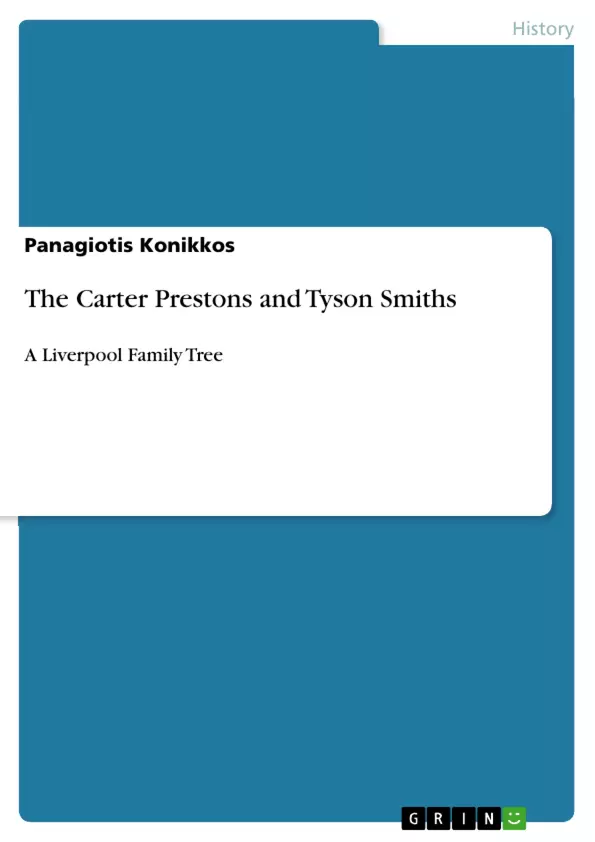The present study explores the transformation of the city of Liverpool, from a British commercial city into a centre of culture, architecture, art and sculpture from the late 19th century to the end of 20th century. It analyses the lives, careers and artistic family trees of two of the most important sculptors of the time, Herbert Tyson Smith and Edward Carter Preston (including the potter Julia Carter Preston). Also, it explores medal design, sculpture and architectural decoration in Liverpool at the period, with detailed analysis on the sculptures of the Anglican Cathedral and the Martins Bank building. The period from 1880’s until 1960’s was enough for the Liverpool architects and artists of the time to produce an incredible collection of sculptures and architectural decoration which accompanied the modern Beaux Arts, steel framed buildings. Finally, the architectural decorations, medals, and sculptures were out of favour by the late 20th century and also, the artistic family trees of Herbert Tyson Smith and Edward Carter Preston came to an end after their grandchildren’s generation, with none of them having become a professional sculptor or artist.
Inhaltsverzeichnis (Table of Contents)
- The context of Liverpool at the time...
- The beginning of an Artistic Liverpool.
- The Liverpool School of Applied Arts.
- Family Tree
- Family background of the artists..
- The background of Edward Carter Preston....
- The background of Herbert Tyson Smith......
- The Individuals and their Careers..
- Edward Carter Preston: Painter, sculptor, medalist.…........
- Julia Carter Preston: Ceramicist and potter.......
- Herbert Tyson Smith: Sculptor and medallist.....
- Case Studies.........
- Edward Carter Preston and the Liverpool Cathedral....
- Herbert Tyson Smith and the Martins Bank Building..
- The Relationship of Architecture and Sculpture in Liverpool 1880-1950..
- The 70 years of Architectural sculpture in the City..
- Discussion and Conclusion: Comparison and Contrast of the Artists..
Zielsetzung und Themenschwerpunkte (Objectives and Key Themes)
This study explores the lives and careers of two prominent Liverpool artists, Edward Carter Preston and Herbert Tyson Smith, and their contributions to the city's artistic landscape. The work aims to provide a comprehensive understanding of their individual artistic practices, their family connections, and the broader context of Liverpool's artistic development during the late 19th and early 20th centuries.
- The artistic and cultural environment of Liverpool in the late 19th and early 20th centuries.
- The family connections and artistic influences of Edward Carter Preston and Herbert Tyson Smith.
- The individual artistic practices and contributions of both artists, including their work in sculpture, painting, and ceramics.
- The relationship between architecture and sculpture in Liverpool during this period.
- A comparative analysis of the artistic styles and approaches of Edward Carter Preston and Herbert Tyson Smith.
Zusammenfassung der Kapitel (Chapter Summaries)
The first chapter provides a historical overview of the artistic context in Liverpool during the period of the artists' lives, highlighting the emergence of a vibrant artistic scene and the establishment of the Liverpool School of Applied Arts. Chapter two delves into the family backgrounds of the artists, tracing their lineage and exploring the influences that shaped their artistic development. Chapter three presents detailed biographies of Edward Carter Preston and Herbert Tyson Smith, examining their individual careers and artistic achievements. Chapter four features case studies of two significant projects undertaken by the artists: Edward Carter Preston's work on the Liverpool Cathedral and Herbert Tyson Smith's contributions to the Martins Bank Building. Finally, chapter five explores the relationship between architecture and sculpture in Liverpool, analyzing the role of sculpture in the city's architectural landscape.
Schlüsselwörter (Keywords)
This study focuses on the key themes of artistic development, family connections, architectural sculpture, and the artistic landscape of Liverpool. It examines the careers of Edward Carter Preston and Herbert Tyson Smith, two prominent artists who made significant contributions to the city's artistic heritage. The study also explores the relationship between architecture and sculpture in Liverpool during a period of significant growth and change.
- Quote paper
- Panagiotis Konikkos (Author), 2012, The Carter Prestons and Tyson Smiths, Munich, GRIN Verlag, https://www.grin.com/document/285058



